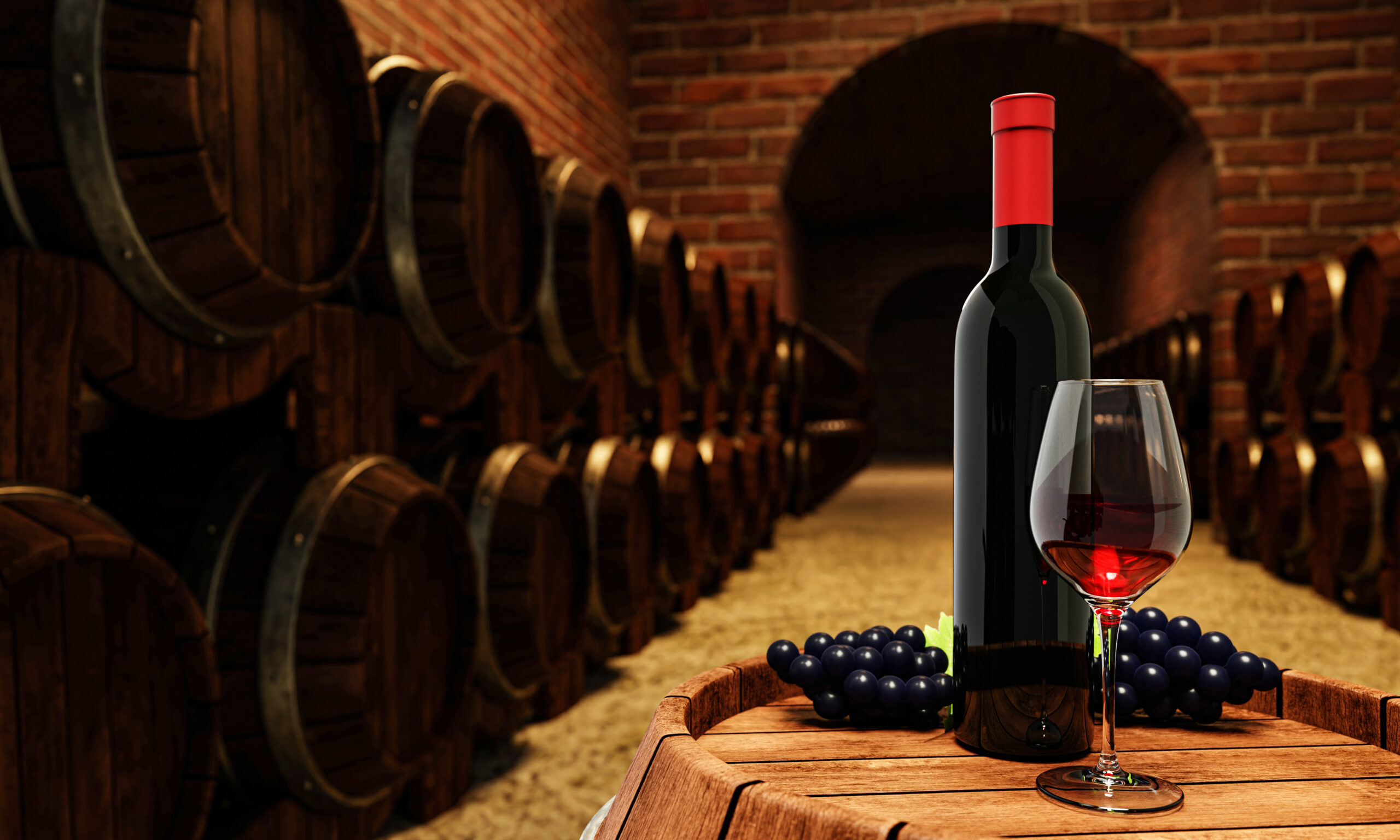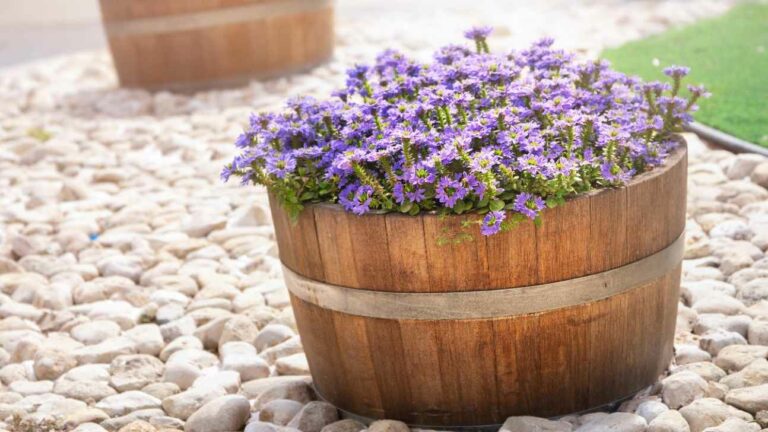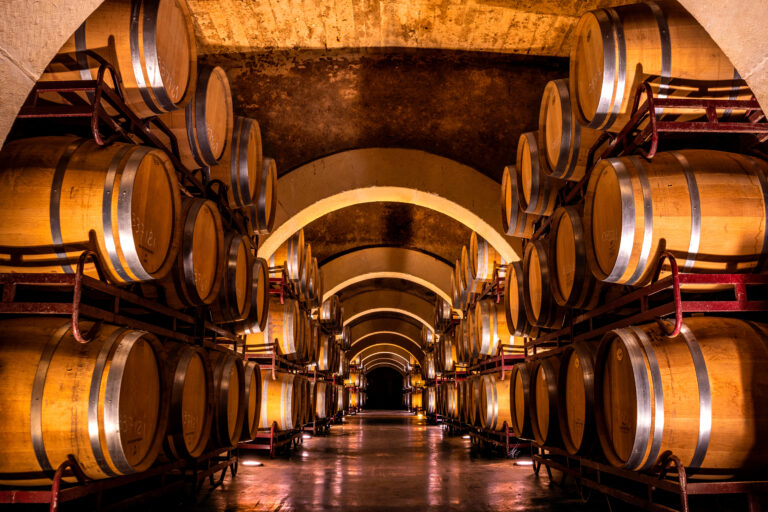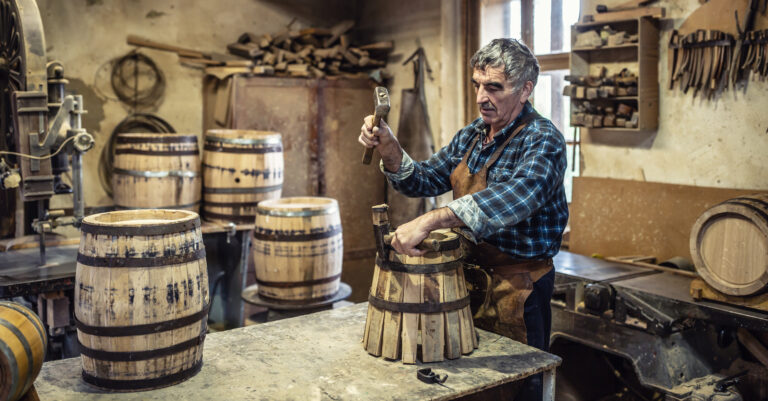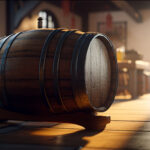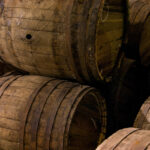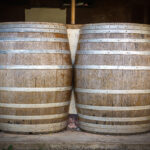Whiskey barrel-aged wine: it’s the latest thing in the wine world, and you’ve probably seen those intriguing bottles on the shelves. Curious? You’ve come to the right place for a quick rundown on this trendy tipple. Basically, it’s wine that’s been aged in used whiskey barrels, usually made of charred oak. This gives the wine some seriously cool flavors – think woody, smoky, and a touch of caramel. It also gives the wine a lovely golden amber hue. While reds like Cabernet Sauvignon, Merlot, and Malbec are the usual suspects, some adventurous wineries are even using whiskey barrels for whites and Ports. Let’s dive in and learn how this magic happens, and I’ll even give you some recommendations to try. Get ready to become a whiskey barrel wine aficionado in no time!
What’s the Deal With Whiskey Barrel Wine?
Whiskey barrel wine is exactly what it sounds like: wine aged in barrels that previously held whiskey. Those barrels, even after the whiskey is gone, are still packed with the spirit’s flavor. Wineries capitalize on this, aging their wine in these used barrels to pick up notes of whiskey, oak, and vanilla.
The type of whiskey that was in the barrel beforehand makes a difference too. Bourbon barrels, for example, tend to lend sweeter notes like caramel, while rum barrels can impart tropical fruit flavors. The wine soaks up these subtle tastes and aromas as it ages.
Winemakers are pretty selective about which wines go into whiskey barrels. They choose wines that will play well with the added flavors. Bold reds like Cabernet Sauvignon, Merlot, and Malbec are popular choices. That barrel aging also contributes to the wine’s unique golden amber color.
Whiskey barrel-aged wine has become a favorite because of the complex flavors it gets from this “double-barreling.” It turns an ordinary wine into something special, something richly flavored that appeals to both wine lovers and whiskey fans. If you’re someone who enjoys the combo of wine and spirits, you have to try it. You’ll taste the difference that charred oak barrels make.
A Little History Lesson: How Did This Happen?
Ever wonder how someone came up with the idea of aging wine in whiskey barrels? It all started with a bit of experimentation. Back in the 1970s, some winemakers started playing around with used whiskey barrels to see if they could add some interesting new flavors to their wines.
The Early Days of Experimentation
Initially, they focused on red wines like Cabernet Sauvignon and Zinfandel, using bourbon barrels. The oak gave the wine vanilla and coconut flavors, and the leftover bourbon added hints of caramel and spice. California wineries were the pioneers here, and the result was a bold, complex wine that people went crazy for.
The word got out, and soon, wineries all over the world were trying their hand at aging wine in used whiskey barrels. Each barrel, and each type of spirit, gave the wine a different flavor profile. Rum barrels might add a touch of tropical fruit, while brandy barrels could bring out candied fruit notes.
These days, you can find whiskey barrel-aged wines made from all sorts of grapes, from Malbec to Chardonnay. While they’re not exactly mainstream yet, these innovative wines are building a following of people who appreciate their layered flavors. Next time you’re at your local wine shop, grab a bottle – you might just find your new favorite.
How Whiskey Barrel Aging Changes the Wine
Aging wine in whiskey barrels has a big impact on its flavor. As the wine sits in those charred oak barrels, it absorbs compounds from the wood, which changes its taste and aroma.
Vanilla and Caramel, Please!
The toasted inside of the barrels gives the wine vanilla flavors and a hint of caramel or butterscotch. The longer the wine ages, the more these sweet, creamy notes come out.
A Touch of Smoke
The charred wood also gives the wine a subtle smoky flavor. It’s not overpowering – more like a distant campfire, with wisps of smoke drifting by. This adds some real depth and complexity.
Spice It Up
You’ll also get notes of clove, cinnamon, and nutmeg, along with the oak flavors. The spiciness is balanced, making the wine feel warm and cozy. The oak itself adds structure and a nutty, almost toasted coconut flavor.
Softening the Edges
The barrel aging process softens the tannins in the wine, which can sometimes be a little bitter. This makes the wine smoother and rounder in your mouth. It takes the edge off and gives the wine a velvety texture.
A More Enticing Aroma
The wine’s aroma becomes more complex, with richer scents of vanilla, caramel, and spice mixing with the wine’s natural fruit smells. You get layers of aroma that are really inviting.
In short, whiskey barrel aging makes subtle but complex changes that turn the wine into something really special. The interplay between the fruit, the wood, and time creates a whole new sensory experience.
Grapes That Love the Barrel
When winemakers are making barrel-aged wine, they often use grapes that can hold their own against the oak flavors. Here are some of the most popular choices:
- Cabernet Sauvignon: This full-bodied red is a natural for barrel aging. Its bold flavors of black currant, cedar, and sometimes tobacco are a great match for oak.
- Merlot: A softer red, Merlot offers flavors of plum, black cherry, and chocolate, which complement oak nicely. Merlot-based wines are often blended with Cabernet Sauvignon.
- Malbec: This inky red from Argentina has jammy flavors of blackberry, blueberry, and violet. Barrel aging helps soften Malbec’s strong tannins and acidity.
- Chardonnay: For white wine, Chardonnay is a top pick. Its citrus and tropical fruit flavors balance out the vanilla and spice from the oak. Barrel fermentation and aging are key to making that popular oaky Chardonnay style.
- Viognier: This aromatic white grape has stone fruit flavors like apricot, peach, and nectarine. When aged in barrels, Viognier gets a richer mouthfeel and hints of oak spice.
- Syrah: Also known as Shiraz, Syrah makes medium to full-bodied reds with black pepper, blackberry, and smoked meat flavors that pair perfectly with oak. Barrel aging helps soften Syrah’s strong tannins.
With the right grape and oak barrel, winemakers can create complex, flavorful wines that people will enjoy for years. It’s a real art, this pairing of grape and oak, and it’s responsible for some of the world’s most famous wines.
The Whiskey Barrel Aging Process: A Step-by-Step Guide
Aging wine in whiskey barrels is actually pretty simple, but it does take patience. First, winemakers find used whiskey barrels, usually made of charred American white oak. Then, they fill those barrels with a bold, full-bodied red wine, like Cabernet Sauvignon, Merlot, or Malbec.
The Wine Goes In
The wine is poured into the barrels, where it will stay for quite a while, developing complex flavors. For the first few months, the wine mainly picks up flavors from the wood, like vanilla, caramel, and smoke.
Time Does Its Thing
As time passes (usually 6-24 months), the wine also starts to absorb flavors from the whiskey that was previously in the barrel. This adds notes of dried fruit, spice, and toast. The longer the wine ages, the more pronounced these whiskey-influenced flavors become. Winemakers will often taste the wine regularly to make sure it’s reaching the perfect balance of wood and whiskey flavors.
Bottling Time
Once the winemaker is happy with how the wine has aged, it’s bottled and ready to drink. Because this is a small-batch process, each bottling of whiskey barrel wine will have its own unique flavor profile. No two are exactly alike.
This simple three-step process – pouring the wine in, letting it age, and then bottling it – results in a bold, complex wine that gives you a taste of both wine and whiskey in every sip. The process might be straightforward, but the flavor is anything but.
Different Barrels, Different Flavors
The type of barrel used makes a huge difference in the final flavor of the whiskey barrel-aged wine. Here are some of the common types:
- American Oak: Barrels made from American oak, usually from Missouri or Kentucky, tend to give the wine sweeter notes of vanilla, caramel, and coconut. Wines aged in American oak often have a slightly smoky character too. These barrels are usually medium char, which means they have visible charring marks inside.
- French Oak: French oak barrels, typically from forests in Limousin or Tronçais, give the wine aromas of baking spice, nutmeg, and cinnamon. They tend to be more subtle than American oak. French oak barrels are typically medium-plus toast, with light charring.
- Hungarian Oak: Hungarian oak barrels fall somewhere between American and French oak. They give the wine flavors of almond, nuttiness, and tropical fruit. Hungarian oak barrels are medium toast.
Ultimately, the type of barrel, the level of toasting, and where the oak comes from all affect the flavor of the finished whiskey barrel-aged wine. Winemakers choose their barrels carefully to complement the type of grape and style of wine they’re making. There are so many possibilities for experimentation!
Barrel-Aging Wine at Home: A Quick Guide
Want to try barrel-aging wine at home? Here’s a quick guide. Start with a good quality wine and a good oak barrel. Look for a barrel that’s already been used for bourbon or wine – it’ll have some complex flavors ready to share. Make sure you sanitize the barrel before you add your wine.
Pour your wine into the barrel and seal it up tight. For the first few days, keep an eye out for any leaks. As it ages, check on it regularly and top it off with more of the same wine to prevent too much oxygen from getting in.
Store the barrel somewhere cool and with a consistent temperature, away from direct light. A garage or basement is usually a good bet. Ideally, you want the temperature to be between 55 and 65°F.
After 6 to 24 months, start tasting and smelling your wine to see if it’s got the level of oakiness and complexity you’re after. Once it’s just right, bottle it up and enjoy your homemade barrel-aged wine!
With a little patience, the right barrel, and some regular care, you can make a really special barrel-aged wine to enjoy for years. Aging wine at home lets you control the whole process and create something that’s exactly to your taste.
Where to Find Whiskey Barrel-Aged Wines
So, you’re ready to try some whiskey barrel-aged wine. Where do you find it? Here are a few ideas:
- Wineries: Lots of wineries, especially the smaller, boutique ones, make whiskey barrel-aged wines. Often, you can only buy these at their tasting rooms or through their wine clubs. Do a little research on wineries near you or where you’re planning to travel – see if they make any barrel-aged wines. These limited releases tend to sell out fast, so buying directly is your best bet.
- Specialty Wine Shops: High-end wine shops, especially those that focus on rare, small-production wines, might have some whiskey barrel-aged wines. Because they’re not widely available, these wines can be a bit pricey. But a good wine shop can often help you track down a specific bottle if you’re looking for something in particular.
- Online Retailers: Some online wine shops, like K&L Wines, Wine.com, and Last Bottle, specialize in rare, hard-to-find wines, and they might have a few whiskey barrel-aged options that they can ship (depending on your state’s laws). Prices will probably be higher than if you bought directly from the winery, but the convenience might be worth it.
- Auctions: Rare wine auctions, whether they’re live or online, often feature high-end, limited-release wines, including those aged in whiskey barrels. But be warned: auction prices can be much higher than the original retail price. Only buy from an auction if you’re prepared to pay a premium for an exclusive bottle.
Finding whiskey barrel-aged wines might take a little effort and patience. But like any treasure hunt, finding that perfect bottle makes the reward even sweeter. The search is part of the fun for any wine lover.
Whiskey Barrel Wine FAQs
What is Whiskey Barrel Wine, exactly?
It’s wine that’s been aged in used whiskey barrels. The barrels give the wine flavors of vanilla, spice, and oak. The porous wood also lets the wine breathe, which mellows it out.
How Does It Taste Different?
The whiskey barrels add warm, layered flavors like caramel, toffee, and spice that you won’t find in regular oak barrel-aged wine. The leftover whiskey also adds subtle smoky, nutty notes.
Does It Taste Strongly of Whiskey?
No, the whiskey influence is pretty subtle. The main flavors are still those of the wine itself. The barrel just enhances the wine’s natural fruit and oak flavors. The result is a unique, complex blend of characteristics from both the wine and the whiskey.
What Kinds of Wine Work Best?
Big, bold reds with lots of tannins, like Cabernet Sauvignon, Malbec, and Tempranillo, hold up well to whiskey barrel aging. Some white wines and lighter reds can also work, especially if they’re only aged briefly. Ultimately, it depends on the winemaker’s creativity and what they want to experiment with.
Where Can I Buy It?
Lots of craft wineries and micro-distilleries now make whiskey barrel-aged wines, but availability depends on where you live. Some larger retailers, like Total Wine and BevMo, also carry a selection of whiskey barrel wines from around the world. Prices usually range from about $15 to $50 a bottle.
Whiskey barrel-aged wine is a cool new trend for people who like adventurous wines and spirits. If you enjoy unusual, full-flavored wines and the warmth of whiskey, you should definitely give it a try. The combination of wine and whiskey barrel is a match made in heaven.
Final Thoughts
So, there you have it – a quick introduction to whiskey barrel wine. Now you know enough to start exploring this fun and unique type of wine. Next time you’re at your local wine shop, keep an eye out for a bottle of whiskey barrel wine. Pour yourself a glass, relax, and enjoy the blend of wine and whiskey flavors. The mix of sweet fruitiness from the wine and the warm, woody notes from the whiskey barrel is sure to delight your taste buds. You can officially consider yourself a whiskey barrel-aged wine connoisseur. And when your friends ask what you’re drinking, you can casually drop some knowledge about this distinctive winemaking process.
